Breadcrumb Trail Links
CultureBooksLifeEating & Drinking
Paris-based writer and food stylist Rebekah Peppler takes culinary inspiration from the south of France in Le Sud
Get the latest from Laura Brehaut straight to your inbox Sign Up
Published Jun 21, 2024 • Last updated Jun 23, 2024 • 10 minute read
You can save this article by registering for free here. Or sign-in if you have an account.
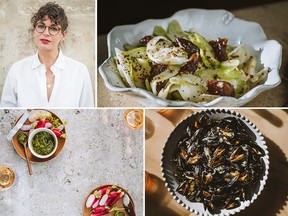 Clockwise from top left: Paris-based writer and food stylist Rebekah Peppler, celery and fennel salad, mussels in aïoli, and radishes and radish leaf pesto. PHOTOS BY JOANN PAIArticle content
Clockwise from top left: Paris-based writer and food stylist Rebekah Peppler, celery and fennel salad, mussels in aïoli, and radishes and radish leaf pesto. PHOTOS BY JOANN PAIArticle content
Reviews and recommendations are unbiased and products are independently selected. Postmedia may earn an affiliate commission from purchases made through links on this page.
Our cookbook of the week is Le Sud: Recipes from Provence-Alpes-Côte d’Azur by Paris-based writer and food stylist Rebekah Peppler.
Jump to the recipes: radishes and radish leaf pesto, mussels in aïoli, and celery and fennel salad.
Advertisement 2
This advertisement has not loaded yet, but your article continues below.
THIS CONTENT IS RESERVED FOR SUBSCRIBERS
Enjoy the latest local, national and international news.
Exclusive articles by Conrad Black, Barbara Kay and others. Plus, special edition NP Platformed and First Reading newsletters and virtual events.Unlimited online access to National Post.National Post ePaper, an electronic replica of the print edition to view on any device, share and comment on.Daily puzzles including the New York Times Crossword.Support local journalism.
SUBSCRIBE FOR MORE ARTICLES
Enjoy the latest local, national and international news.
Exclusive articles by Conrad Black, Barbara Kay and others. Plus, special edition NP Platformed and First Reading newsletters and virtual events.Unlimited online access to National Post.National Post ePaper, an electronic replica of the print edition to view on any device, share and comment on.Daily puzzles including the New York Times Crossword.Support local journalism.
REGISTER / SIGN IN TO UNLOCK MORE ARTICLES
Create an account or sign in to continue with your reading experience.
Access articles from across Canada with one account.Share your thoughts and join the conversation in the comments.Enjoy additional articles per month.Get email updates from your favourite authors.
THIS ARTICLE IS FREE TO READ REGISTER TO UNLOCK.
Create an account or sign in to continue with your reading experience.
Access articles from across Canada with one accountShare your thoughts and join the conversation in the commentsEnjoy additional articles per monthGet email updates from your favourite authors
Article content
The sparkling seaside, medieval hilltop villages and plentiful produce of the south of France pulled Rebekah Peppler in. “I think I speak for a lot of people when I say what hooked me was the magic that is the south of France,” says the Paris-based writer and food stylist, who devoted her third cookbook, Le Sud (Chronicle Books, 2024), to the region of Provence-Alpes-Côte d’Azur.
“It has this very idyllic feel when you first set foot in it. It feels like a place you might have known but maybe dreamt of, and it turns out it’s a real place where real people live. It has four seasons and all that fun stuff. And you get to visit it — or, if you’re lucky, spend a lot of time there researching, say, a book.”
Peppler has lived in Paris since 2015 and started visiting Provence on summer vacation. She made friends there who opened restaurants and hotels and began to visit off-season. “It’s just as magical, if not more so, when you’re not in that August rush of summer vacances.”
Advertisement 3
This advertisement has not loaded yet, but your article continues below.
Article content
The idea for Le Sud crystallized over years of travelling to the region. Peppler’s first cookbook, Apéritif (2018), focused on drinks and snacks the French way. She followed it with À Table (2021), which expanded from the apéro hour to encompass the modern French table from start to finish. For what eventually became Le Sud, she wanted to incorporate more opportunities for storytelling — from a journalist’s perspective rather than a visitor’s to uncover aspects of the region people wouldn’t know from experiencing it at the surface level.
Peppler grew up in Oshkosh, Wisconsin, where she graduated with a bachelor’s degree in journalism. After moving to New York City, she got a pastry arts degree from the International Culinary Center. When she considered a topic for her third book, she asked herself what she knew just enough about but wanted to learn more. The south of France was the answer. She made a list of places she’d stayed in Provence-Alpes-Côte d’Azur and wanted to revisit with a journalist’s eye, as well as a list of new sites to ensure she captured the full range of the region.
Cook This
Thanks for signing up!
Article content
Advertisement 4
This advertisement has not loaded yet, but your article continues below.
Article content
At the same time, before she sold the book, Peppler got sick with COVID-19 in March 2020, which morphed into an illness now known as long COVID. Bed-bound and extremely weak, she knew something was wrong but wasn’t getting any answers from her doctors. “I was like, ‘Well, at this point, I’m the only person that can be in charge of my healing. So, what heals me the most? What do I do that’s always worked in the past, and I’ll try that.’ And it was to go to the sea and to be by saltwater.” She went to La Ciotat, a port city in Provence-Alpes-Côte d’Azur, and spent a month on the Mediterranean, attempting to recover.
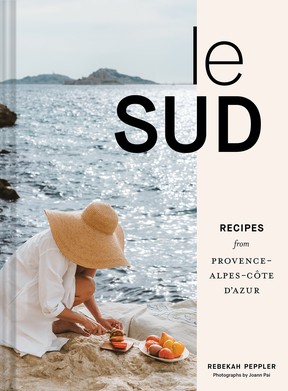 Le Sud is Paris-based writer and food stylist Rebekah Peppler’s third book. Photo by Chronicle Books
Le Sud is Paris-based writer and food stylist Rebekah Peppler’s third book. Photo by Chronicle Books
La Ciotat still has a special place in her heart, and Le Sud was informed by her experience spending time in the south of France for reasons other than fun. “It’s not just this magical wonderland of vacation to me and the people living there. And I wanted to make sure to translate that into the book as well.”
Advertisement 5
This advertisement has not loaded yet, but your article continues below.
Article content
Whenever Peppler starts a book or any large project, she writes a wish list of things she wants for it. For Le Sud, she wrote “Julia?” in a notebook early in the planning process. In 1965, Julia Child and her husband, Paul Child, built a Provençal vacation home, La Pitchoune. Now owned by American Makenna Held, it’s a cooking school and vacation rental. Peppler ended up staying at La Pitchoune while working on Le Sud, tapping into the history of Americans finding culinary inspiration in southern France.
Canadian photographer Joann Pai, based in Paris, took the book’s photos throughout Provence-Alpes-Côte d’Azur, which Peppler art directed and styled. The images of Child’s Provençal kitchen in the middle of winter were some of Peppler’s favourites.
Advertisement 6
This advertisement has not loaded yet, but your article continues below.
Article content
“I got to walk into the kitchen every morning, in the dark before anybody else was up, and make my coffee and do my writing routine, which is the same wherever I am: it’s coffee and light some candles, and it’s early morning,” says Peppler. “It was such a magical experience to do that from this space that is so historic and so full of past lives of Americans in Paris and Americans in France, and Americans in the south of France, specifically, writing about French food. It felt very inspirational, and I tried to infuse that into the book in both the text and the images.”
In addition to shooting at Child’s house near Grasse, they shot in Marseille at the end of summer to capture the long days, sun and sea. They stationed themselves in Ménerbes in the Luberon Valley in October to catch the distinct autumnal light hitting the hilltop villages. “We shot in different seasons because I wanted the book to have that beautiful, summer, seaside Provence vibe but also capture the whole breadth of Provence.”
Advertisement 7
This advertisement has not loaded yet, but your article continues below.
Article content
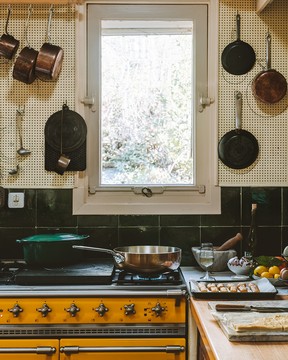 Rebekah Peppler stayed in Julia Child’s Provençal house, La Pitchoune, while writing Le Sud, tapping into the history of Americans finding culinary inspiration in southern France. Photo by Joann Pai
Rebekah Peppler stayed in Julia Child’s Provençal house, La Pitchoune, while writing Le Sud, tapping into the history of Americans finding culinary inspiration in southern France. Photo by Joann Pai
Provence-Alpes-Côte d’Azur is vast, spanning the Southern Alps in the north to the Mediterranean coastline in the south, France’s border with Italy in the east, and the Camargue, rich in rice and salt in the west.
As with the images, Peppler reflects the broad strokes of the entire region in the recipes. She paired a research trip to Menton, near France’s border with Italy, with Tende in the Roya Valley, north toward the Alps. Some pastas are only made in that region, such as sugeli, which Peppler learned to make from Madame Maffei, one of the few people still making it. The Italian influence is strong, but pockets of Provence-Alpes-Côte d’Azur have cultures of their own, which Peppler wanted to showcase in the book.
Advertisement 8
This advertisement has not loaded yet, but your article continues below.
Article content
“You have pasta culture from the influence in Italy on one side. You have all these influences from Africa coming into the port cities on the coast, and then you have all this river cooking and seaside. You have olive oil in one place and rice and fish in another place. You’re getting all of these different aspects, and I wanted to dive into all of them.”
Fish and shellfish feature prominently because of the Mediterranean coastline and the region’s many rivers. Citrus is plentiful in Le Sud, a nod to Menton’s namesake lemon, thick-skinned, fragrant and floral (substituted with Meyer lemons in the book). Peppler shares a few pastas and paella Camarguaise, which she ate her fair share of in the ancient city of Arles.
She features traditional recipes such as ratatouille, tian, and salade Niçoise, but also includes iterations of the dishes that reflect how people cook in Provence today. “The modern way of cooking there hasn’t changed a great deal. But there are so many influences on the cuisine that I think get lost when you only read old texts about Provence. And so, I wanted to create something that felt inclusive of what’s happening now in France in general.”
Advertisement 9
This advertisement has not loaded yet, but your article continues below.
Article content
Recommended from Editorial

Cook This: 3 Turkish recipes from Sebze, including a summery meze

Cook This: 3 summer dessert recipes from Sugarcane, including no-churn halo halo ice cream
RADISHES + RADISH LEAF PESTO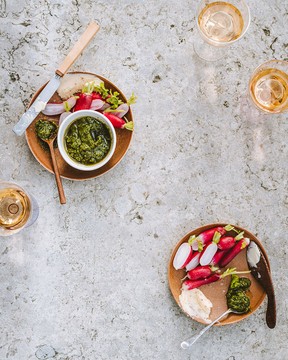 Rebekah Peppler came up with this recipe when she forgot to buy basil at the market. “Now, rather than making it work with extra radish leaves, I buy radishes to make this pesto.” Photo by Joann Pai
Rebekah Peppler came up with this recipe when she forgot to buy basil at the market. “Now, rather than making it work with extra radish leaves, I buy radishes to make this pesto.” Photo by Joann Pai
Serves: 6 | Makes: 1 1/2 cup (360 mL)
1 large bunch radishes, leaves and vegetables separated, leaves picked and cleaned (about 3 tightly packed cups/100 g leaves)
1 large bunch fresh mint, leaves cleaned and picked, stems discarded (about 1 1/2 packed cup/30 g)
1 small garlic clove, grated on a Microplane
3/4 cup (180 mL) extra-virgin olive oil
1 lemon, zested and juiced
1 cup (40 g) finely grated Parmigiano-Reggiano
Fine sea salt
Freshly ground black pepper
Step 1
In a blender or food processor, add the radish leaves, mint leaves and garlic. Pulse to coarsely combine. With the mixer running, add the oil in a steady stream, blending until the pesto is smooth. Add the lemon zest and juice and pulse to combine. Stir in the Parmigiano-Reggiano and season with salt and pepper. Serve with cleaned, chilled and halved radishes.
Advertisement 10
This advertisement has not loaded yet, but your article continues below.
Article content
Note: Radish leaf pesto can be made up to 3 days in advance and stored, covered with additional olive oil drizzled over the top, in the refrigerator.
MOULES IN AÏOLI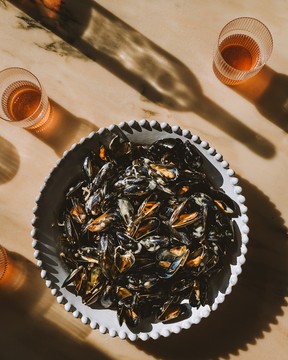 This recipe for mussels tossed in aïoli is a nod to Rebekah Peppler’s favourite beach shack about 20 minutes south of Marseille’s city centre. Photo by Joann Pai
This recipe for mussels tossed in aïoli is a nod to Rebekah Peppler’s favourite beach shack about 20 minutes south of Marseille’s city centre. Photo by Joann Pai
Serves: 6
3 tbsp extra-virgin olive oil
4 shallots, thinly sliced
2 garlic cloves, thinly sliced
Fine sea salt
Freshly ground black pepper
1/4 cup (60 mL) dry white wine or vermouth
4 lb (1.8 kg) mussels (see note)
1 cup (240 mL) aïoli, (recipe follows), for serving
Crusty bread, for serving
Step 1
In a large pot or Dutch oven over medium heat, add the oil. Once the oil is hot, add the shallots and garlic and cook, stirring, until the shallots are translucent, about 5 minutes. Season with salt and pepper and pour in the wine. Let simmer, uncovered, for 5 minutes.
Advertisement 11
This advertisement has not loaded yet, but your article continues below.
Article content
Step 2
Add the mussels to the pot and use a wooden spoon to stir them into the shallot mixture. Cover the pot and cook, stirring halfway through, until the mussels are opened and fully cooked, 6 to 8 minutes.
Step 3
Transfer the mussels to a serving bowl, reserving the broth. Strain the broth through a fine-mesh sieve, discarding the solids. Add the aïoli to a small bowl and gradually whisk in 3 tablespoons of the mussel broth. Spoon the sauce over the mussels, tossing to coat, and serve with crusty bread.
Notes: To prepare the mussels, place them in a colander or fine-mesh sieve and rinse with cold water. Scrub gently to remove any grit and use your hands to remove the “beard” (the thread-like piece attached to the side of the shells) by tugging firmly. If any mussels are open and don’t close when tapped, discard them. Drain and transfer to a large bowl.
Advertisement 12
This advertisement has not loaded yet, but your article continues below.
Article content
Should you like, this dish can be, and often is, served chilled.
AÏOLI
Makes: about 1 cup (240 mL) aïoli
2 large egg yolks
1/4 cup (60 mL) grapeseed or canola oil
1/2 cup (120 mL) extra-virgin olive oil
1 to 2 tbsp fresh lemon juice
2 small garlic cloves, grated on a Microplane
Fine sea salt
Step 1
In a medium bowl, whisk the egg yolks. Whisking constantly, add the grapeseed oil drop by drop until the mixture thickens. Continuing to whisk constantly, pour in the remainder of the grapeseed oil and the olive oil in a slow, steady stream. Add the lemon juice in 1 teaspoon increments, whisking constantly. The aïoli mixture should be pale yellow and thick. Stir in the garlic and season with salt.
CELERY + FENNEL SALAD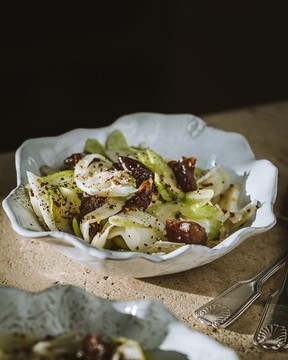 “I make a version of this crunchy, citrusy, caramelized date-topped salad about once a week,” Rebekah Peppler says of her celery and fennel salad. Photo by Joann Pai
“I make a version of this crunchy, citrusy, caramelized date-topped salad about once a week,” Rebekah Peppler says of her celery and fennel salad. Photo by Joann Pai
Serves: 6
3 large fennel bulbs, trimmed, cored and very thinly sliced
8 celery stalks, trimmed and very thinly sliced on the bias
2 lemons, zested and juiced
Fine sea salt
2 tbsp grainy mustard
Hot sauce, if desired
1/3 cup plus 1 tbsp (95 mL) extra-virgin olive oil, plus more for serving
Freshly ground black pepper
8 to 10 dates, pitted
Flaky sea salt
Advertisement 13
This advertisement has not loaded yet, but your article continues below.
Article content
Step 1
In a large bowl, combine the thinly sliced fennel, celery, and lemon zest and juice. Season with fine sea salt and toss to coat. Let sit for 20 to 30 minutes, tossing occasionally.
Step 2
Holding the fennel and celery out of the way with clean hands or a spoon, whisk the mustard and hot sauce (if using) into the lemon juice. Toss to coat, then drizzle with 1/3 cup (80 mL) of the olive oil and season with fine sea salt and pepper. Toss the fennel-celery mixture well to coat with the dressing and taste for seasoning. Set aside.
Step 3
In a medium saucepan set over medium-high heat, add the remaining 1 tablespoon of olive oil. Once the oil is hot, add the dates in a single layer. Cook on the first side until lightly blistered, 45 seconds to 1 minute, then carefully flip the dates and cook for another 30 seconds on the other side. Transfer the dates to a cutting board and sprinkle with flaky sea salt. Coarsely chop and layer on top of the fennel-celery salad, then serve.
Recipes and images excerpted with permission from Le Sud: Recipes from Provence-Alpes-Côte d’Azur by Rebekah Peppler. Published by Chronicle Books, April 2024.
Our website is the place for the latest breaking news, exclusive scoops, longreads and provocative commentary. Please bookmark nationalpost.com and sign up for our cookbook and recipe newsletter, Cook This, here.
Article content
Share this article in your social network
Get the latest from Laura Brehaut straight to your inbox Sign Up
